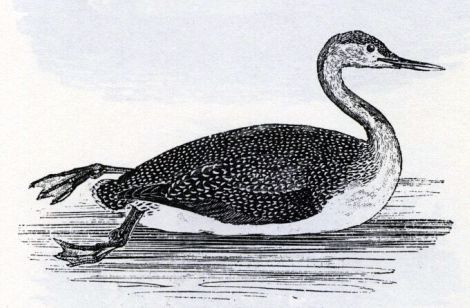January 4
Posted by sydney on Jan 4th, 2009

Speckled Diver, T. Bewick.
- 1793: January 4, 1793 – Rain, rain, gleams. Venus is very resplendent.
- 1789: January 4, 1789 – Began the new hay-rick. Snow on the ground; but the quantity little in comparison with what has fallen in most parts. As one of my neighbours was traversing Wolmer-forest from Bramshot across the moors, he found a large uncommon bird fluttering in the heath, but not wounded, which he brought home alive. On examination it proved to be Colymbus glacialis, Linn. the great speckled diver, or Loon, which is most excellently described in Willughby’s Ornithology. Every part & proportion of this bird is so incomparably adapted to it’s mode of life, that in no instance do we see the wisdom of God in the Creation to more advantage. The head is sharp, & smaller than the part of the neck adjoining, in order that it may pierce the water; the wings are placed forward & out of the center of gravity, for a purpose which shall be noticed hereafter; the thighs quite at the podex, in order to facilitate diving; & the legs are flat, & as sharp backwards almost as the edge of a knife, that in striking they may easily cut the water; while the feet are palmated, & broad for swimming, yet so folded up when advanced forward to take a fresh stroke, as to be full as narrow as the shank. The two exterior toes of the feet are longest; the nails flat & broad, resembling the human, which give strength & increase the power of swimming. The foot, when expanded is not at right angles to the leg or body of the bird; but the exterior part, inclining towards the head, forms an acute angle with the body. Most people know, that have observed at all, that the swimming of birds is nothing is nothing more than a walking in the water, where one foot succeeds the other as on the land; yet no one, as far as I am aware, has remarked that diving fowls, while under water, impell & row themselves forward by a motion of their wings, as well as by the impulse of their feet: but such is really the case, as any person may easily be convinced who will observe ducks when hunted by dogs in a clear pond. Nor do I know that any one has given a reason why the wings of diving fowls are placed so far forward. Doubtless not for the purpose of promoting their speed in flying, since that position certainly impedes it but probably for the encrease of their motion under water by the use of four oars instead of two; yet were the wings & feet nearer together, as in land birds, they would, when in action, rather hinder than assist one another. The Colymbus was of considerable bulk, weighting only three drachms short of three pounds averdupoise. It measured in length from the bill to the tail (which was very short) two feet; & to the extremities of the toes, […]
- 1786: January 4, 1786 – One of the most severe days that I ever remember with a S. wind. The snow on wednesday [today] proved fatal to two or three people who were frozen to death on the open downs about Salisbury. Much damage happened at sea about that time. In particular the Halsewell outer-bound India-man was wercked, & lost on the shore of Purbeck.
- 1777: January 4, 1777 – Dark & thawing, frost, snow on the ground. Larks congregate roads hard, & beaten.
- 1768: January 4, 1768 – The birds must suffer greatly as there are no Haws. Meat frozen so hard it can’t be spitted. Several of the thrush kind are frozen to death.
 Theme Ported to
Theme Ported to